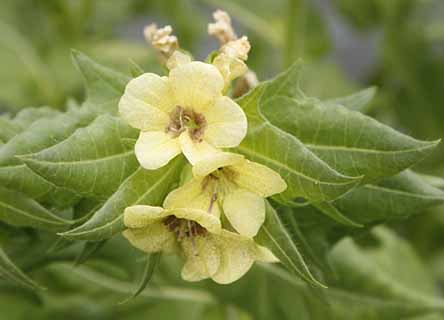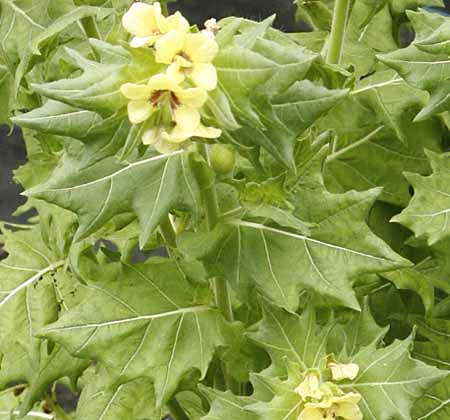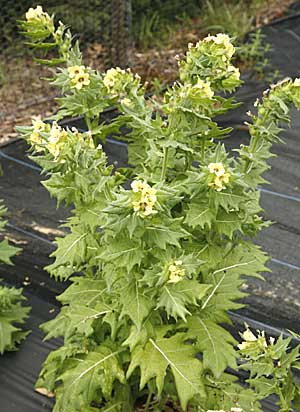A rather pretty annual or biennial plant with large gray green leaves and spikes of yellow flowers. This plant is an interesting conversation piece and makes an different addtion to a herb garden or border plant.
Warning. Black henbane is a very poisonous plant. All parts of the plant are toxic so care should be taken when growing this plant. Do not grow this plant if there are children or pets using the garden.
Description.
Henbane is actually rather a pretty plant. It has large soft oval to lance shaped
gray green leaves which are thickly felted and usually toothed. It sends up
sprays of slightly arching stems with pairs of opposite leaves with no stalks
that are anywhere from 2 to 4 feet in height. The stems are stout and can be
slightly woody especially at the base. The flowers begin to appear in early
to mid summer and are arranged on a arching stems. The lower flowers are shortly
stalked while the upper ones are crowded together on one side of the stem. All
the flowers are dull to mid yellow in color with purple centers and are about
1 inch across. The scent is reported as powerful, oppressive and even nauseous.
The seeds ripen in interesting pitcher shaped calyx vessels bulbous at the lower
end with spikes surrounding the top. The arching stems of seed carapaces are
very attractive.
Henbane is a most interesting plant in that it can be either an annual or a
biennial (two years) both from the same seed stock. Some research has suggested
that it depends on where on the arching stem of flowers the seeds come from
determines which the plant will be, lower on the stem (earlier flowers) produces
biennials while higher ones are annuals, however this is not definitive.
Annual forms tend to be smaller growing to 2 feet in height and flowering in
the first year. They are not as strong and stems tend to be single not branched.
The leaves are not as hairy and the flowers are fully yellow most often without
purple markings. These plants tend to flower in July and August.
The biennial form produces a rosette of leaves in the first year which disappear
in winter. The plant produces a fleshy taproot that looks similar to a parsnip.
In spring the leaves return and tend to be larger often 12" in length and
covered with soft hairs that secrete a resin that can make the leave feel clammy
and sticky . The flower stems arise in early spring and rapidly branch. They
can reach 3-4 feet in height and also have much larger leaves than the annual
form often 9-10" in length. The leaves are pale green with a broad conspicuous
mid-rib. The flowers are the same size and shape but the yellow flowers are
usually marked with a close network of lurid purple veins, although some plants
do not have this feature. Seed capsules are the same as is the flower scent.
Growing.
Modern herbal states that henbane seeds are often obstinate, most often they
germinate well and easily but on occasion they will refuse to germinate for
several months. We have never had a problem on the farm germinating the seeds
and so far cannot confirm that location of seed on the stem produces annual
or biennial plants, they seem arbitrarily mixed. Sowing directly in the ground
has been recommended but we have had no problem transplanting seeds provided
that they are potted not bare rooted.
Location and Care.
Henbane will grow in most locations, as long as it has sunshine. Its not too
fussy about the type of soil but it does need to be well drained, it will not
tolerate waterlogged conditions. It needs only moderate amounts of water but
wont tolerate drought for too long. It needs only moderate care to keep the
weeds down otherwise its fairly maintenance free.
However due to its odor it
should be planted away from houses decks and patios.
Pests
Henbane is a native to Europe and a member of the potato family, it is therefore
susceptible to insects that attack potatoes so care should be taken to ensure
pests are kept at bay. We have never had a problem with such insects however
large green caterpillars will often defoliate our plants sometimes getting through
one large plant in a single day so if interested in harvesting the leaves be
watchful.
Use
Henbane has been associated with magic and lore for centuries and is still used
in witch crafting and magic rites today. It is also considered a very powerful
pharmaceutical drug and is grown as a crop plant in many parts of Europe for
this purpose and for pharmaceutical research.
The whole of this plant is very poisonous and care should be taken around its
leaves. If intending to harvest ensure you are well protected before touching
the leaves. Always grow in a responsible manner and in places that are not accessible
to young children and pets.








